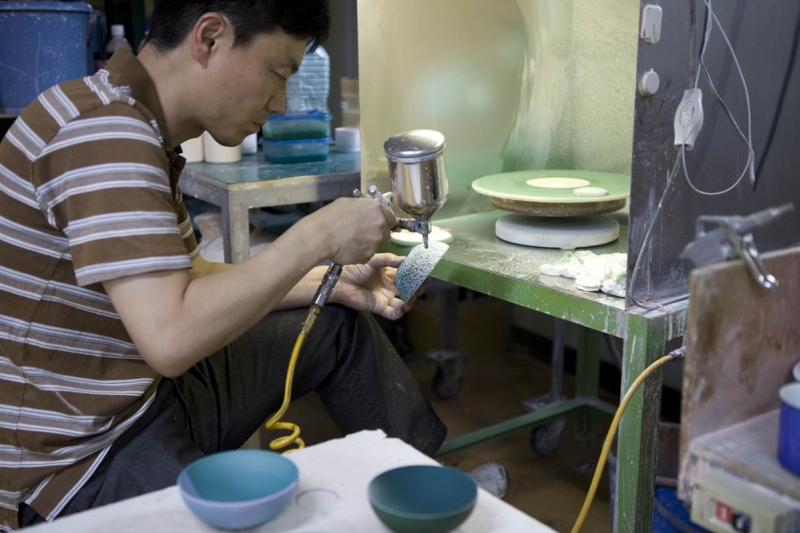Interview: Mr. Yamaguchi, Kinemon Toen
Since its establishment in 1926 the Kinemon Toen pottery has developed decorative porcelain tableware. For 2016 / they have produced a striking new collection using an airbrushed glaze technique. We asked Mr. Yamaguchi of Kinemon Toen pottery how he surmounted the difficulties that arose during this ambitious production.
- Kinemon Toen Pottery is well known for a airbrushed glaze, a type of glazing that uses two different glazes and for producing Cochin: colourful porcelain that is often vivid yellow and green. How did glazing techniques and colour feature in the production of Kueng Caputo’s design?
Glaze is a key feature in the production of this collection: Kinemon Toen Pottery receives porcelain bodies after biscuit firing from greenware factories in Arita (we also biscuit fire some porcelain bodies ourselves). We check these thoroughly for scratches and I finish the surfaces perfectly with sandpaper. These careful checks of the porcelain vessels are important as their finish affects the coloured glaze later. We then go on to mask the center of the object and apply a gradation of airbrushed glaze onto its side and then the centre. The object is then fired.
- How difficult were Kueng Caputo’s sculptural forms to make?
Kueng Caputo’s products are made by slip casting. Normally, with a vase for example, it would be cast from the top. These shapes were very different however and so we cast them differently: from the back of the product towards the surface. Their surface is indented and so it is difficult to remove the porcelain body from the mold without deforming it, the process had to be done slowly.
- How were the final colours determined?
I sent samples of many colours to the designers in Switzerland. The selection was narrowed down when the designers visited us in Arita and we focused on matte finishes.
- The visual effect of shadow falling across the vessels is very effective. How did you achieve it?
In order to make the gradation, we need to find a good angle from which to spray the glaze. The colour and the finish appear different when it is first sprayed and after it has been fired. Even slight changes in temperature during firing can make a huge difference. We apply years of experience when predicting the colour of the glaze but even now it is still difficult to determine.
We also produced Shigeki Fujishiro’s products for 2016/ and these too have an airbrushed matte glaze in red and gray. It is difficult to stabilise the matte glazes. Normally they would be lightly coloured but the 2016/ products demanded strong and bold colours instead.
- Kinemon Toen were involved in the successful project 1616 / arita japan, which was a precursor for the 2016/ collections. Do you predict success for these new collections of Arita porcelain too?
Kueng Caputo’s products have been a challenge to make. Just like with the products we made for 1616 / arita japan, it takes time to find the right processes. And when we begin mass production for the 2016/ collection, new and different challenges will be encountered which are about balancing the skills of the craftsmen and women and adapting the production processes to suit a larger production.
- What sort of feedback did you receive after announcing launching your collections at the Milano Salone in April?
The professionals understood that these shapes are difficult to produce and I received compliments that the gradation of glaze was perfectly produced. It was great to hear those comments in person.










